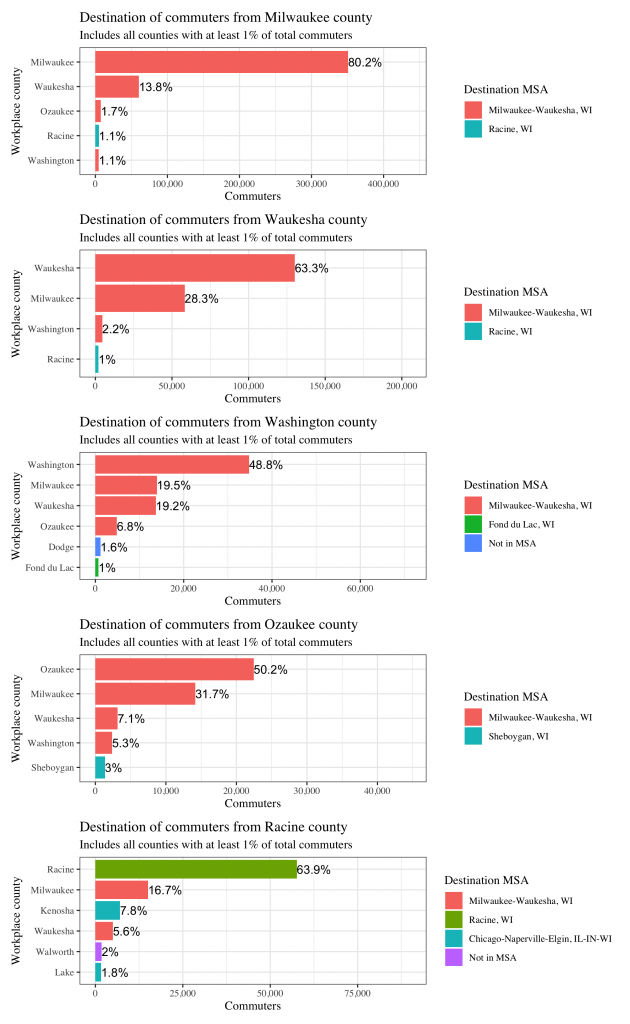The Milwaukee Metropolitan Statistical Area (“The Milwaukee Metro”) consists of Milwaukee, Waukesha, Washington, and Ozaukee counties, but not Racine County. Why not? Racine County, home to Wisconsin’s fifth largest city, lies just to the south of Milwaukee County. The answer to this question reveals much about the economic geography of southeastern Wisconsin. Despite its close physical proximity to the Milwaukee Metro, Racine County still lacks economic integration with its neighbor to the north. There are doubtlessly many ways in which Racine is part of the “Greater Milwaukee Area,” but workforce connectivity (the key metric used to define metro areas) is not one of them.
Understanding core based statistical areas
Metropolitan Statistical Areas are a vital concept for understanding American cities because the legal boundaries of “central cities” vary so much from one place to another and because the cultural, economic and social web of a city extends well beyond wherever those political boundaries calcified. Since 1949 the federal government has defined what are currently called “core based statistical areas” (CBSAs). A CBSA containing at least one urbanized area with at least 50,000 or more residents is a “metropolitan statistical area.” Smaller CBSAs are “micropolitan statistical areas.” As the term “core-based” suggests, Micro- or Metro-politan areas are centered around one or more principal cities. The most populous municipality in each CBSA is a principal city by default, but additional cities are designated principal cities if they draw large numbers of commuters in their own right. The Los Angeles metropolitan area has 19 principal cities, for instance. The Milwaukee Metro has two principal cities–Milwaukee and Waukesha.
The boundaries of core based statistical areas are defined using commuter flows. There are two main ways for a place to be part of a CBSA. One way is to be a commuter hub–a principal city–drawing in workers from the rest of the region. In an MSA with multiple principal cities, each will act as an interconnected hub, with large numbers of workers commuting each direction every day. As I wrote in 2017, “Milwaukee city attracts the most workers—some 125,000 in total. Still, nearly 95,000 people leave the city for work every day. Thirty-thousand of them go to Waukesha county, while 30,000 in Waukesha commute to the city of Milwaukee. The net-worker balance between Milwaukee city and Waukesha county is virtually equal.” The other way for an area to be part of a CBSA is as a commuter suburb. Some places attract very few outside workers, but provide a large number of employees for other towns. Muskego in Waukesha county is a good example. Eighty-five percent of its workers commute somewhere else, and the town’s population shrinks by about 30% during the workday.
Few workers commute from Milwaukee or Waukesha to Racine
Given this criteria, Racine County is in an odd situation. Like Waukesha, it has a principal city of its own. Reflecting this, about two-thirds of workers from Racine and Waukesha counties alike commute to work within their county of residence. This is much more than Washington or Ozaukee counties where just half of commuters work in their county of residence. Again like Waukesha county, Racine county does send more than a few workers to the Milwaukee metro. Seventeen percent go to Milwaukee county and 6 percent to Waukesha. But this relationship is not reciprocal. Just 1 percent of Milwaukee county workers commute to Racine, compared to 14 percent going to Waukesha. Waukesha sends 28 percent of its workers to Milwaukee but just 1 percent to Racine.
Racine County has a one-way commuter relationship with the Milwaukee metro area. The City of Racine is a commuter hub locally, but its pull does not reach far. Thirteen Milwaukee county workers commute west to Waukesha county for every 1 who travels south to Racine County.
Racine doesn’t do much better with its southern neighbor Kenosha county, either. Kenosha county is classified as part of the Chicago MSA. About 27 percent of its workers travel to Illinois compared to just 11 percent who work in Racine.
The boundaries of metropolitan statistical areas are intended to describe reality, not shape it. In the future, Racine’s economy may become intertwined with Milwaukee’s in the same way that Milwaukee and Waukesha have grown into a single economic unit. The Foxconn project could be the catalyst needed to make this shift (if it is ever completed). In the meantime, however, Racine remains a close cousin, if not a sibling member of the Milwaukee Metro.

